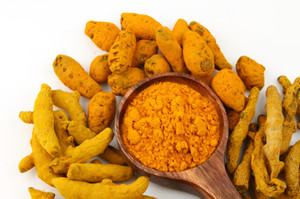Turmeric, or Curcuma longa, is an ancient spice popular in India and Asia as far back as 2,000 BC.
Contents
Uses
- Research has proven these curcuminoids exert powerful health-promoting effects via 160 mechanisms and pathways in the body such as antioxidant, neuroprotective, immunomodulatory, anti-inflammatory, epigenetic, and adaptogenic properties.
- Turmeric imparts a vibrant yellowish hue to curry dishes, and the spice is also used as a natural dyeing agent for cloths.
- Culinary uses
Benefits
1. Promotes Balanced Mood
A randomized, double-blind, placebo-controlled study in the Journal of Affective Disorders showed noticeable and promising results with turmeric for supporting a balanced mood. Two groups were studied over 8 weeks. The first group received curcumin daily, while the other received placebo. After 8 weeks, the depression and anxiety score tests completed by all of the participants showed significant symptom improvements compared to placebo. Could turmeric be a potential new option for stabilizing mood?
2. Helps Wounds Heal
Cut your finger? A study in the Sept 2014 issue of Life Sciences found that turmeric (curcumin) has beneficial properties that appear to speed the wound healing process. These modes of action include the modulation of redness and welling and oxidation. As new studies come to light showing turmeric’s ability to potentiate the body’s natural healing processes and outcome, the possible breadth of applications could be enormous.
An exciting study in the Oct 2006 issue of Molecular and Cellular Biochemistry demonstrated the efficacy of a topical turmeric application for wounds in rats. The results showed that turmeric increased collagen synthesis rates, improved wound contraction, and increased tissue strength and cell proliferation around the wound. Turmeric also showed antioxidant properties that helped the healing process.
3. Aches and Discomfort
An impressive study completed and published in the March 2014 issue of the Journal of Clinical Interventions in Aging looked at the effect of turmeric on knee osteoarthritis pain and function. In the 4-week study, two groups were randomized and divided; one group received turmeric extract, while the other group received the daily upper limit dose of ibuprofen.
Results showed that the turmeric group experienced discomfort relief just as much as the ibuprofen group. The turmeric group, however, seemed to enjoy more relief from joint stiffness. Those taking turmeric reported significantly less side effects than those taking NSAIDs. A double-blind, placebo-controlled study in the December 2011 issue of Surgical Endoscopy looked at turmeric supplementation on postoperative discomfort and fatigue in patients who had gallbladder surgery. Patients taking turmeric experienced significantly less pain and fatigue (per pain scale log assessments) at intervals of 3 weeks, as compared to placebo.
4. Encourages Balanced Blood Sugar
A novel investigative study published in the Nov 2014 issue of The Journal of Endocrinology looked at the effects of curcumin on the insulin-producing cells of the pancreas called Beta cells (or B-cells) and Islet cells, in relation to type-2 diabetes. Researchers treated B-cell lines and human Islet cells with preparations of turmeric and reported a number of positive benefits.
6. Helps Stiff Joints
A randomized, pilot clinical study was published in the November 2012 issue of Phytotherapy Research. The goal of the study was to see the effectiveness and/or difference in the relief of active joint discomfort. One study group received the standard-of-care medication (diclofenac sodium), while the other received turmeric. Patients were given symptom score sheets (DAS/ACR) to assess results. Turmeric outperformed diclofenac sodium on all levels, including being relatively free from adverse side effects.
7. Cholesterol Optimization
Turmeric’s ability to help the body regulate and balance cholesterol levels has been hypothesized and studied since the 1990s with varying levels of benefits. A couple of these studies show an impressive reduction in lipid profiles and cholesterol markers in turmeric-supplemented groups. One randomized, single-blind clinical study published in the November 2011 issue of Phytotherapy Research set out to investigate turmeric’s effect on cholesterol and triglyceride levels.
Group participants were given either turmeric (curcumin) in low or high doses, and a control group was given vitamin E only. After just seven days, the results proved statistically significant. Low-dose turmeric showed the most improvement as compared to the other two groups, with serum cholesterol levels being reduced by 17% and triglycerides being slashed a whopping 47%!
Another study conducted a similar seven day trial. Results showed the turmeric (curcumin) supplemented participants had reduced serum cholesterol by 12%, reduced lipid peroxides (cholesterol byproduct marker) by 33%, and increased HDL cholesterol (the good kind) by an impressive 29%. Most importantly, these studies show that turmeric is consistently safe and has very low risk of side effect.
8. Ulcers
India has long used turmeric in curry dishes as a taste and color enhancer. Another key reason turmeric has been used in so many cultural dishes in the East for millennia is because of its soothing properties on digestion. Researchers wanted to test the protective effects of turmeric on the lining of the stomach against acidic preparations (ethanol) used to induce stomach ulcers in test animals (representative of humans).
A preparation containing the essential oils from turmeric was administered prior to the ethanol and the results were impressive. Turmeric inhibited stomach ulcer formation by an impressive 85%. Lesions, tissue necrosis, and hemorrhaging were also greatly reduced. In addition, turmeric also appears to offer some impressive protection for stomach ailments.
Cautions
- Please see: http://nutrawiki.org/turmeric/ and consult with your doctor.
Interactions
- Please see: http://nutrawiki.org/beta-glucan/ and consult with your doctor.
Other names
Curcuma, Curcuma aromatica, Curcuma domestica, Curcumae longa, Curcumae Longae Rhizoma, Curcumin, Curcumine, Curcuminoid, Curcuminoïde, Curcuminoïdes, Curcuminoids, Halada, Haldi, Haridra, Indian Saffron, Nisha, Pian Jiang Huang, Racine de Curcuma, Radix Curcumae, Rajani, Rhizoma Cucurmae Longae, Safran Bourbon, Safran de Batallita, Safran des Indes, Turmeric Root, Yu Jin
References
Source: Global Healing Centre, http://www.globalhealingcenter.com/natural-health/8-impressive-health-benefits-turmeric/

